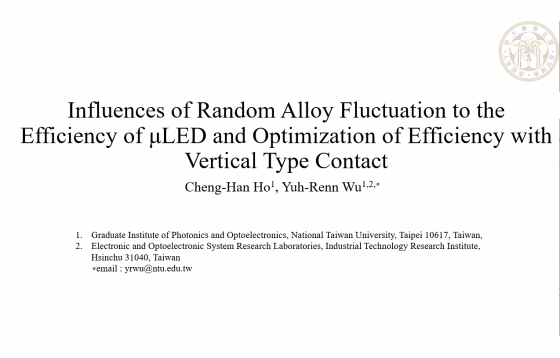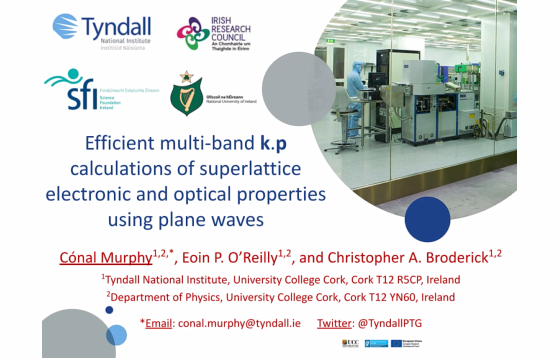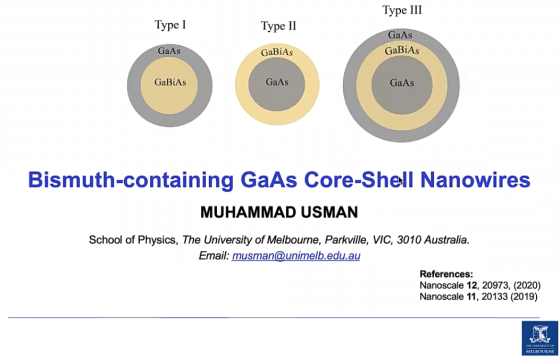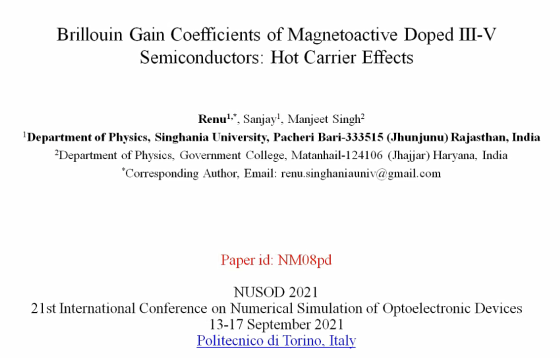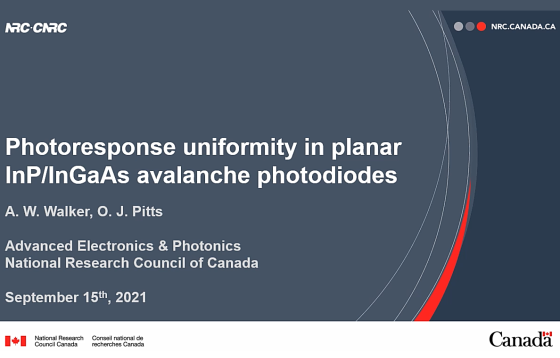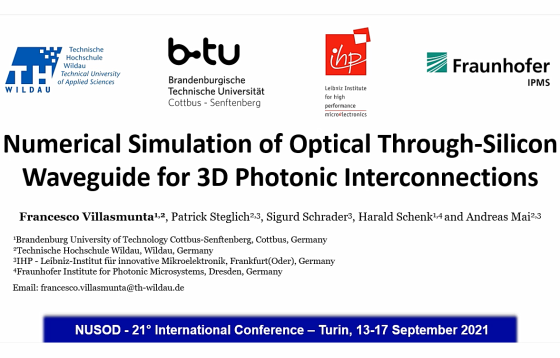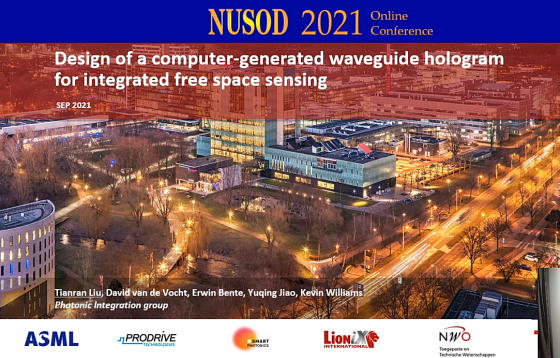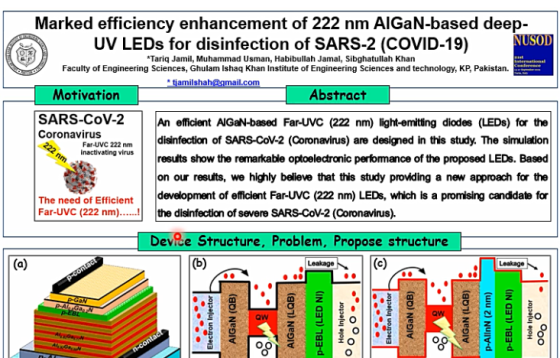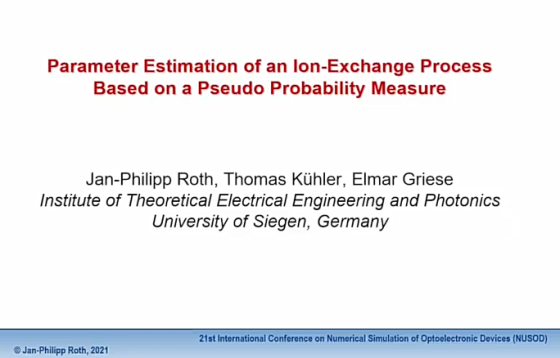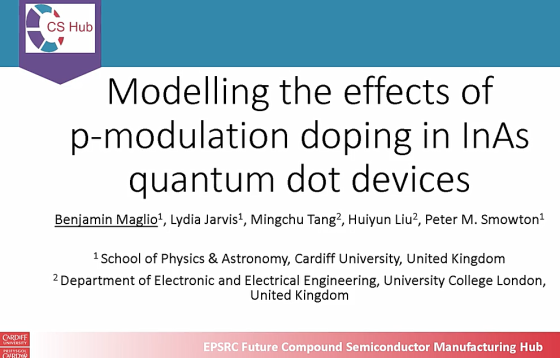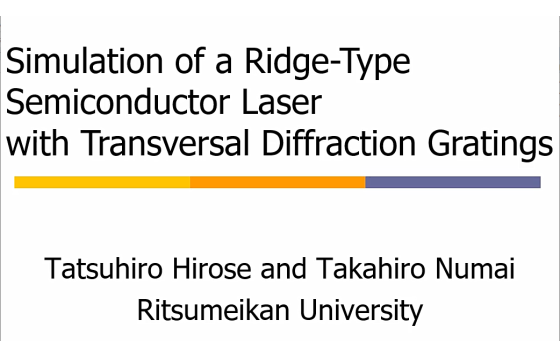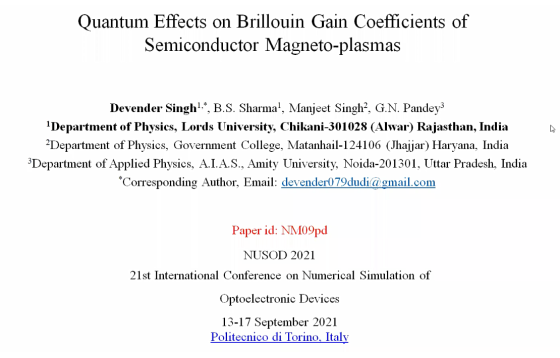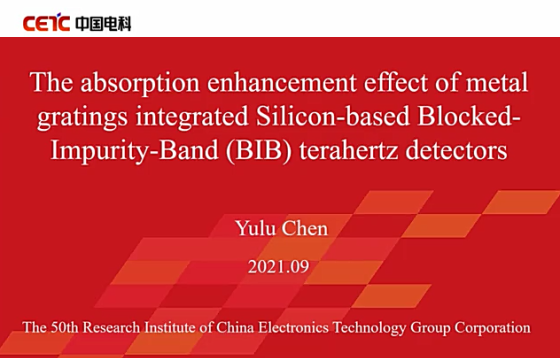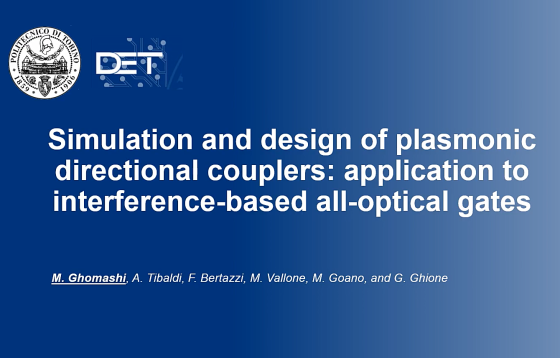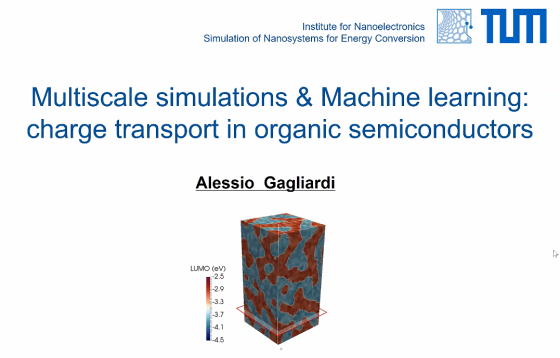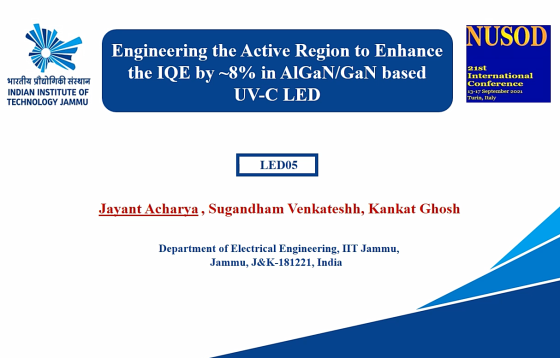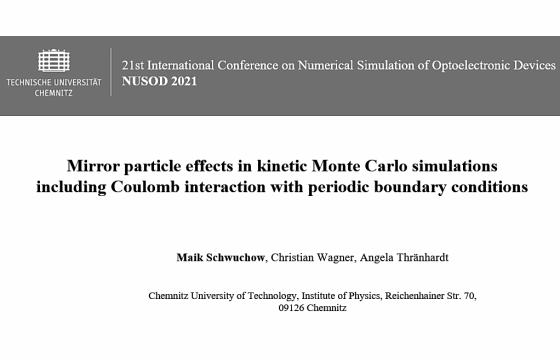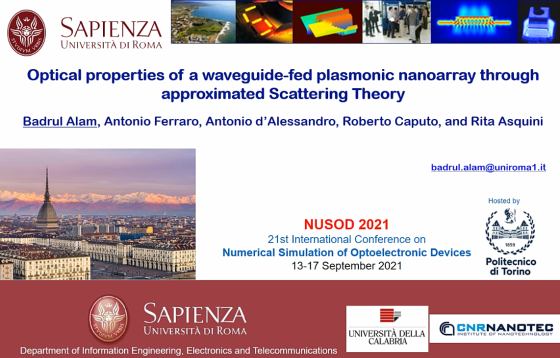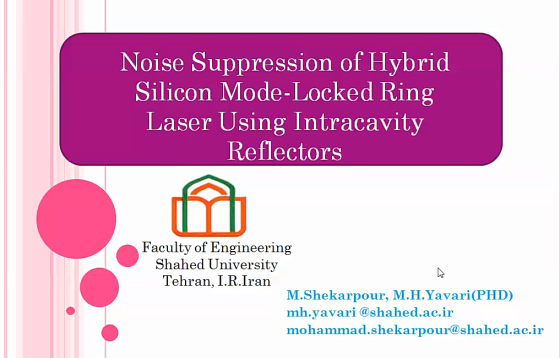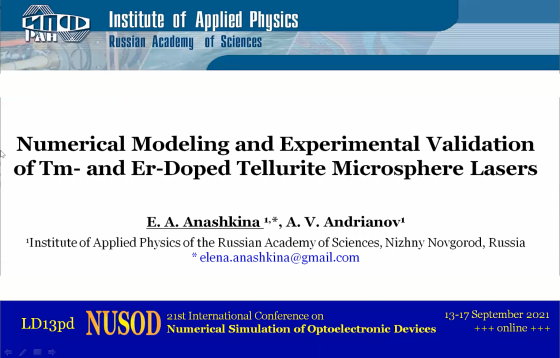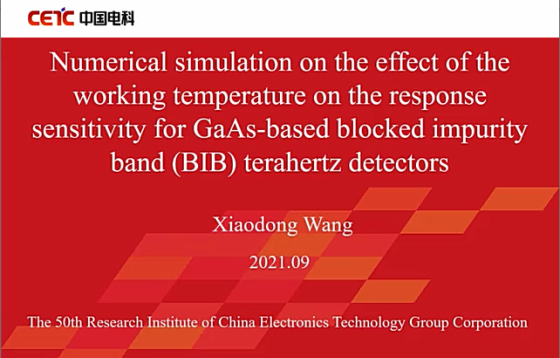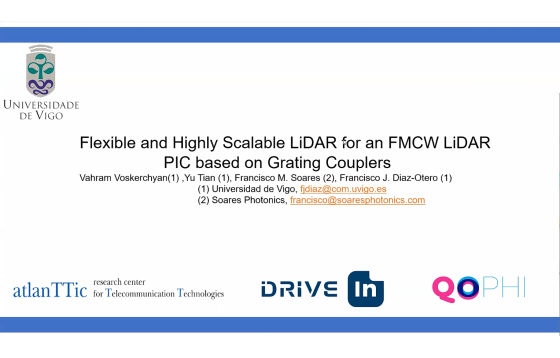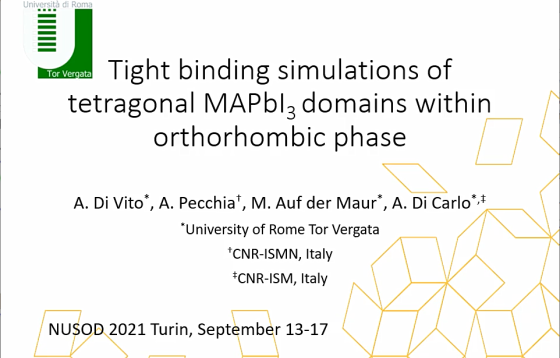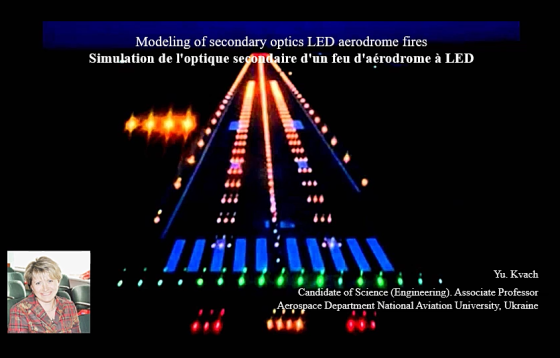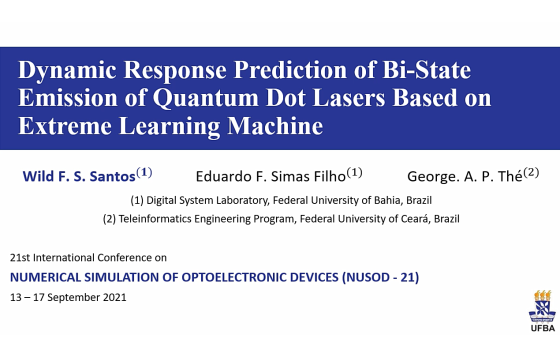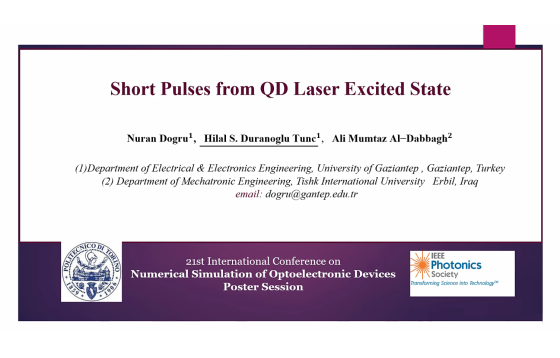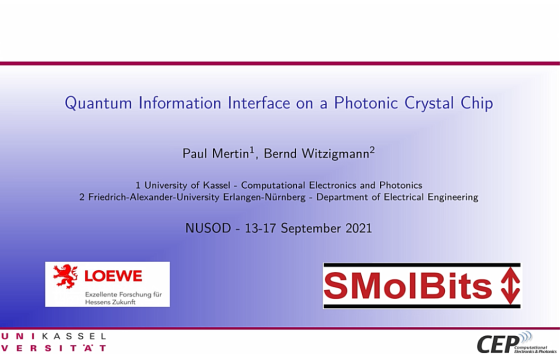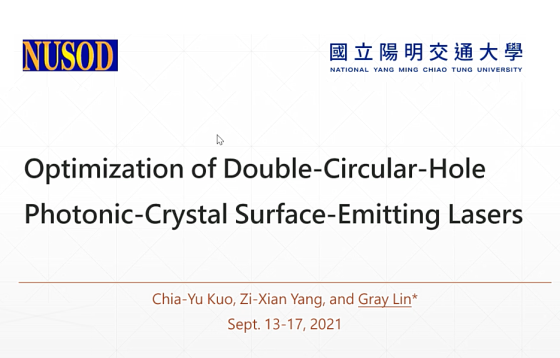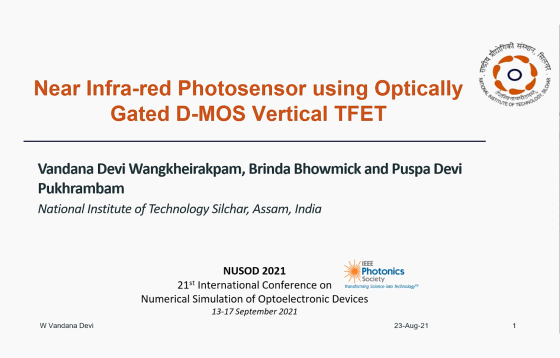


µ-LED’s efficiency is enormously dependent on the chip size, which is believed to be the influence of sidewall traps. However, the decrease of IQE in AlInGaP based red LED is much stronger than nitride based LEDs. This paper examines the role of random alloy fluctuation with our 2D simulation software for the whole LED chip […]
MM02–Efficient multi-band k·p calculations of superlattice electronic and optical properties using plane waves
Solving the multi-band k·p Schrodinger equation for a quantum-confined heterostructure using a reciprocal space plane wave approach presents several advantages compared to conventional real space approaches such as the finite difference or element methods. In addition to allowing analytical derivation of the heterostructure Hamiltonian, a desired level of accuracy in the computed eigenstates can generally […]
N04–Bismuth-containing GaAs core-shell nanowires
This work theoretically investigates the electronic and optical properties of GaBixAs1–x/GaAs core–shell and GaAs/GaBixAs1–x/GaAs multi-core–shell nanowires. Our results show a large tuning of absorption wavelength (0.9 µ to 1.6 µ) by varying Bi composition and/or nanowire diameters. The computed polarisation dependent optical spectra indicate the possibility to incorporate such nanowires in photonic devices desiring isotropic […]
LD10–Optical Feedback Regimes Suitable for Distance Measurement with a Ring Laser
We numerically study the behavior of a ring laser subject to bidirectional delayed optical feedback, when the isolated laser is in the quasi-unidirectional regime. We find different regimes, two of which are of special interest, because the laser switching period, between the clockwise and the counter-clockwise mode, is linearly related to the time of flight […]
NM08pd–Brillouin Gain Coefficients of Magnetoactive Doped III-V Semiconductors: Hot Carrier Effects
Hot carrier effects (HCEs) of an intense pump wave on (steady-state and transient) Brillouin gain coefficients of magnetoactive doped III-V semiconductors are investigated. Numerical analysis is made for n-InSb crystal – CO2 laser system.
D06–Photoresponse uniformity in planar InP/InGaAs avalanche photodiodes
Numerical simulation of the electric field distribution and photocurrent response of a planar InP/InGaAs avalanche photodiode is presented as a function of varying multiplication width. The Zn dopant diffusion front is obtained by numerically simulating the diffusion process. The simulation results indicate that while a local peak value of the electric field is observed near […]
IS02–Numerical Simulation of Optical Through-Silicon Waveguide for 3D Photonic Interconnections
Optical interconnections are a promising step forward to overcome the intrinsic limitations of electrical interconnections in integrated circuits. In this work, we present a finite element method (FEM) simulation study of a dielectric waveguide etched through the full thickness of a silicon substrate. In particular, it is investigated the effect of the bridge-to-core size ratio […]
P01–Design of a computer-generated waveguide hologram for integrated free space sensing
In this work we present a design of a computer generated waveguide hologram coupler with an ultra-long working distance and wavelength multiplexing in the near infrared. An approximation method to compute the scalar field from a detour phase hologram is presented. The accuracy is comparable to FDTD but it is achieved much faster. Coupling efficiency […]
LED04–Marked efficiency enhancement of 222 nm AlGaN-based deep-UV LEDs for disinfection of SARS-2 (Covid-19)
The AlGaN-based deep ultraviolet light emitting diodes (DUV LEDs) for the disinfection of SARS-2 (Covid-19) are proposed in this study. The optoelectronic characteristics of DUV LEDs are numerically analyzed. The results show that the internal quantum efficiency (IQE) and radiative recombination rate are excellently improved in the proposed LED. This significant enhancement is due to […]
MM03–Parameter Estimation of an Ion-Exchange Process Based on a Pseudo Probability Measure
For the realization of integrated optical waveguide components, needed for integrated photonic circuits, a promising approach to manufacturing is their embedding in thin glass sheets by thermal diffusion processes. Because prototyping or manufacturing small batch series is costly, appropriate numerical simulations are used in order to allow an accurate characterization. However, in practical applications it […]
N05–Modeling the effects of p-modulation doping in InAs quantum dot devices
A modeling routine has been developed to quantify the effects of p-modulation doping in the waveguide core region of InAs quantum dot (QD) devices. Utilizing one dimensional approximations, simulated outputs of reverse and forward devices are simulated providing insight into absorption and gain properties.
LD11–Simulation of a Ridge-Type Semiconductor Laser with Transversal Diffraction Gratings
This paper reports on improvement of stability of the fundamental horizontal transverse mode in a ridge-type semiconductor laser by incorporating transversal diffraction gratings. Kinks do not appear in current versus light-output curves by appropriately designing the number of the grating periods when the mesa width is 5 µm.
NM09pd–Quantum Effects on Brillouin Gain Coefficients of Semiconductor Magneto-plasmas
Using QHD model, quantum effects (QEs) on (steady-state and transient) Brillouin gain coefficients of semiconductor magneto-plasmas are investigated. Numerical analysis is made for n-InSb crystal – CO2 laser system.
D07–The absorption enhancement effect of metal gratings integrated Silicon-based Blocked-Impurity-Band (BIB) terahertz detector
High-sensitivity Terahertz (THz) detection technology is widely researched for its potential applications in astronomical observation, human security check, weak signal biomacromolecule detection, etc. In this work, a novel THz detector based on metal gratings/Si-BIB hybrid structure is theoretically simulated and successfully fabricated. From FDTD simulation results, the optical field is localized in the absorbing-layer region […]
IS03–Simulation and design of plasmonic directional couplers: application to interference-based all-optical gates
The paper is focused on the design of optical components based on plasmonic multi-slot directional couplers. In particular, the design of an all-optical gate is proposed, whose operation is based on the coupling between three plasmonic slots. The device input wavelength is 1550 nm, typical of long-haul telecommunication systems. The device footprint is as small […]
NM01–Machine Learning & multiscale simulations: toward fast screening of organic semiconductor materials
Organic semiconductor devices promise cost-efficient processability at low temperatures, but the usually amorphous materials suffer from low charge carrier mobility. The search for high mobility organic semiconductor materials has thrived data science and Machine Learning approaches to screen the vast amount of possible organic materials. We present a multiscale simulation model based on machine learned […]
LED05–Engineering the Active Region to Enhance the IQE by ~8% in AlGaN/GaN based UVC LED
To increase the internal quantum efficiency (IQE) of AlGaN/GaN based multi quantum-well (MQW) UV-C LED, the aluminium composition of barriers and wells in the active region has been engineered. Increase in electron-hole overlap and hence the radiative recombination rate in the final engineered structure has enabled to enhance the IQE by 8%.
MM04–Mirror particle effects in kinetic Monte Carlo simulations including Coulomb interaction with periodic boundary conditions
We investigate the photoluminescence of low-dimensional disordered materials, as used e.g. in solar cells, by performing kinetic Monte-Carlo simulations of exciton hopping with periodic boundary conditions. In order to perform numerically efficient calculations, the box length Lbox should be as small as possible while maintaining physically meaningful results during the presence of exciton-exciton-interaction. Exciton-exciton interaction […]
N06–Optical properties of a waveguide-fed plasmonic nano-array through approximated scattering theory
We analyze the optical scattering properties of an array of Au nano-cylinders fabricated upon an ion-exchanged waveguide. The integrated systems is considered for fluoroscopy and Raman spectroscopy. Absorption, scattering and extinction have been calculated through a combination of Finite Difference Time Domain (FDTD) method and scattering theory. While a portion of the excitation signal interacts […]
LD12–Noise Suppression of Hybrid Silicon Mode-Locked Ring Laser Using Intracavity Reflectors
We have proposed harmonically hybrid silicon mode-locked ring laser using intracavity reflectors (ICR’s) to suppress supermode noise. The dynamic and noise propertiesof ring laser for without-reflector structures (WOICRS) and proposed structure (PS) are investigated using a delay differential equation model (DDE).
LD13pd–Numerical Modeling and Experimental Validation of Tm- and Er-Doped Tellurite Microsphere Lasers
We report an efficient semi-analytical method for modeling of CW rare-earth ion-doped microlasers. We numerically simulated threshold pump powers and expected laser wavelengths for in-band pumped Tm- and Er-doped tellurite glass microspheres. With the increase of Q-factor, the laser wavelength grows smoothly for Tm and there are jumps from the C-band to the L-band for […]
D08–Numerical simulation on the effect of the working temperature on the response sensitivity for GaAs-based blocked impurity band (BIB) terahertz detectors
Working temperature is a critical parameter to evaluate the performance of Gallium Arsenide (GaAs) blocked impurity-band (BIB) terahertz detector. An optimal devicetemperature can ensure the best response sensitivity. Therefore, we analyze the effect of device temperature on the response sensitivity characteristics of GaAs-based BIB detector by numerical simulation. The simulated result shows that the optimal […]
IS04–Flexible and Highly Scalable LiDAR for an FMCW LiDAR PIC based on Grating Couplers
In this paper three types of Silicon Photonics OPA architectures are proposed and investigated. Edge-fire optical phased array, that simplifies the design of the OPA. Second architecture is OPA with grating coupler antennas. Maximum steering angle for edge-fire OPA is ±44◦, FWHM is 0.10986◦. For GC OPA steering angle is ±20◦ and FWHM=1.003116◦. Third architecture […]
NM03–Tight binding simulations of tetragonal MAPbI3 domains within orthorhombic phase
Very recent photoluminescence studies, investigating the tetragonal-to-orthorhombic phase transition of MAPbI3, demonstrated the presence of residual tetragonal phase far below the transition temperature, yielding spectral signatures from quantum confined tetragonal domains. We present a theoretical model of the coexistence of tetragonal and orthorhombic MAPbI3, based on tight binding simulations. The tight binding parameters are derived […]
LED06–Modeling of secondary optics LED aerodrome fires
The development of LED technology has allowed the Ukrainian Association of Lighting Enterprises of Vatra Corporation to develop the construction of LED equipment for the airfield light signal systems. Features of fire design, angles of installation of fires, difficulties in observing LED aerodrome fires – these factors influence the decision making when establishing visual contact. […]
MM05–Dynamic Response Prediction of Bi-State Emission of Quantum Dot Lasers Based on Extreme Learning Machine
Dual-state emission is an phenomenon which takes place in Quantum Dot Lasers at different temperature and operating conditions. In this study, we investigate that issue from a nonlinear regression model based on Extreme Learning Machine, which revealed to be able to predict the spectrally resolved transient response of InAs/InGaAs quantum dot laser with error performance […]
N07–Short Pulses from QD Laser Excited State
For the first time gain-switched short pulse generation with a width of 25-40 ps from excited state is demonstrated applying an external optical Gaussian beam to the excited state of InAs-InP-(113)B quantum dot laser.
P02–Quantum Information Interface on a Photonic Crystal Chip
Quantum systems for information processing rely on the distribution of quantum information in a network. Lanthanide complexes coupled to an optical cavity can act as an interface between a stationary and a flying QuBit. Here we show that in such a system the stationary quantum information can be mapped onto a photon, paving the way […]
LD14pd–Optimization of Double-Circular-Hole Photonic-Crystal Surface-Emitting Lasers
Photonic-crystal surface-emitting lasers (PCSELs) with double circular holes in the unit cell are optimized in terms of slope efficiency and single-mode stability. For PC-SELs with double-hole shift of one-fourth and one-third lattice constant, the area ratios of two holes are optimized separately and fall in completely different range; moreover, their threshold gain discrimination values are […]
D09–Near Infra-red Photosensor using Optically Gated D-MOS Vertical TFET
This article reports a highly sensitive and low power photosensor using dual MOSCAP Vertical TFET for near infrared light detection in the wavelength range 0.7µm to 1µm. The optical voltage (VOP) developed because of the photogeneration occurring within the gate region enhances the gate control over the channel and produces higher drain current. The sensitivity […]

